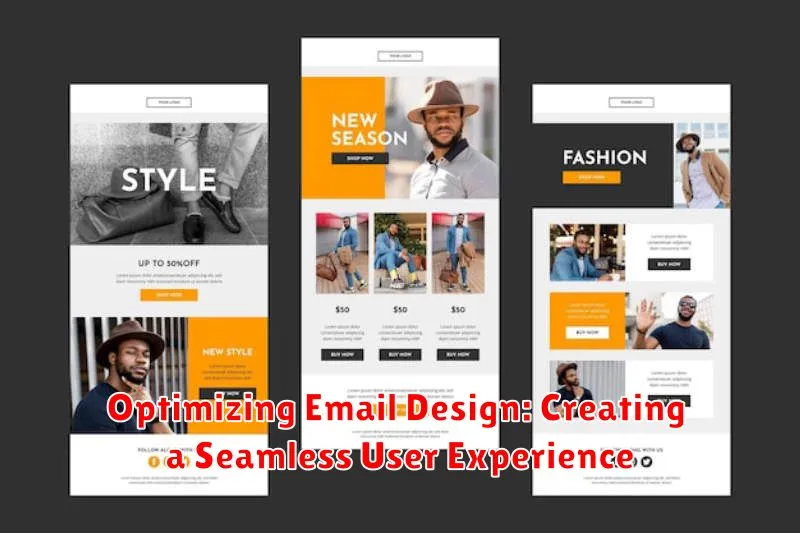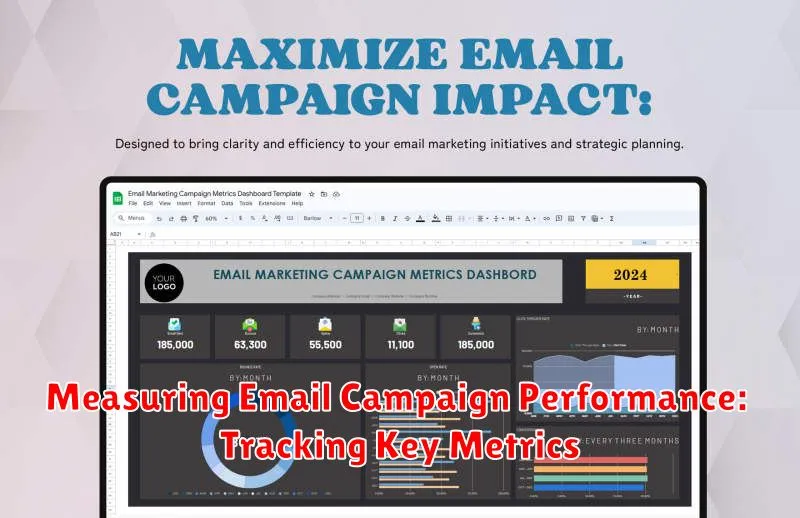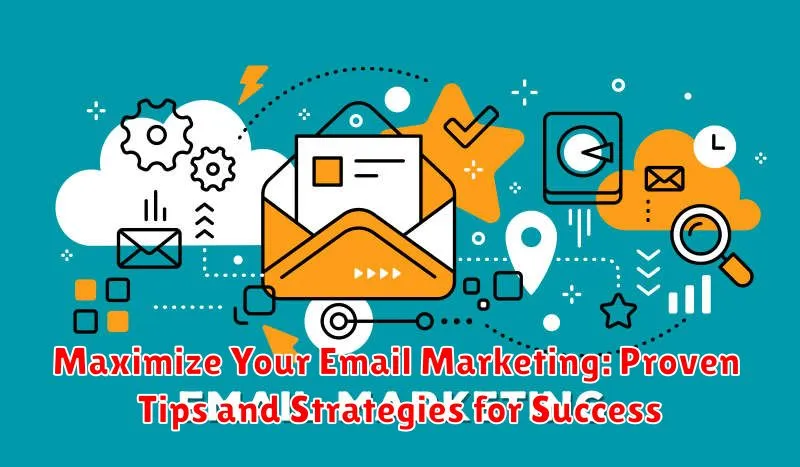In today’s digital landscape, email marketing remains a powerful tool for businesses to connect with their audience, nurture leads, and drive conversions. A well-executed email marketing strategy can significantly impact your bottom line, fostering customer loyalty and boosting sales. Whether you’re just starting out or looking to refine your existing approach, understanding the key principles of effective email marketing is crucial for success. This article will provide proven tips and strategies to help you maximize your email marketing efforts and achieve measurable results.
From crafting compelling subject lines that grab attention to segmenting your audience for targeted messaging, we’ll explore the essential elements of a successful email marketing campaign. Learn how to optimize your email content, improve deliverability, and analyze your results to continuously refine your strategy. Discover how to leverage email automation and personalization to create engaging experiences that resonate with your subscribers and drive conversions. By implementing the tips and strategies outlined in this article, you can unlock the full potential of email marketing and achieve your business objectives.
Building a Targeted Email List: Quality over Quantity
A large email list might seem impressive, but it’s ultimately ineffective if it’s filled with unengaged subscribers. Targeted email marketing focuses on attracting subscribers genuinely interested in your offerings. This approach yields higher open rates, click-through rates, and ultimately, conversions.
Prioritize quality over quantity by implementing strategies that attract the right subscribers. Offer valuable lead magnets such as ebooks, exclusive content, or webinars that resonate with your target audience.
Implement clear opt-in methods. Avoid pre-checked boxes and clearly state what subscribers are signing up for. This ensures subscribers understand what to expect and reduces the likelihood of unsubscribes later.
Segment your audience from the beginning. Use signup forms to collect relevant data like industry, interests, or purchase history. This allows you to tailor future email campaigns and provide more personalized content.
Regularly clean your email list by removing inactive or bounced email addresses. This improves deliverability rates and ensures your metrics accurately reflect engaged subscribers.
Crafting Compelling Subject Lines: Grabbing Attention in the Inbox
Your subject line is the first, and often only, impression you make on a potential reader. A compelling subject line is crucial for getting your emails opened. It’s the gateway to your content, and a weak one can land your message directly in the trash.
Keep your subject lines concise and to the point. Aim for around 50 characters or less to avoid truncation on various devices. Clarity is key; recipients should instantly understand what awaits them inside the email.
Create a sense of urgency or exclusivity to encourage immediate opens. Phrases like “limited-time offer” or “exclusive preview” can be effective. However, avoid excessive use of exclamation points or all caps, which can trigger spam filters and appear unprofessional.
Personalization can significantly improve open rates. Use the recipient’s name or other relevant data to create a more targeted and engaging experience. A/B testing different subject lines can provide valuable insights into what resonates best with your audience.
Personalizing Your Emails: Connecting with Your Audience
In the digital age, where inboxes are overflowing, personalization is key to cutting through the noise and fostering genuine connections with your audience. It’s no longer enough to simply blast out generic emails; you need to tailor your messages to resonate with individual recipients.
Using a subscriber’s name is the most basic form of personalization. Go beyond simply inserting their name in the greeting. Leverage the data you’ve collected, such as past purchases, browsing history, or demographic information, to create targeted content that aligns with their interests and needs.
Segmented email lists play a vital role in personalization. By dividing your subscribers into specific groups based on shared characteristics, you can deliver more relevant and impactful messages. This could involve creating separate lists for different customer segments, product categories, or engagement levels. For example, a clothing retailer might segment their list by gender to promote relevant items.
By personalizing your emails, you demonstrate that you value your subscribers as individuals, leading to increased engagement, higher click-through rates, and ultimately, a stronger customer relationship. This targeted approach transforms your email marketing from a generic broadcast into a personalized conversation.
Optimizing Email Design: Creating a Seamless User Experience

Effective email design is crucial for engaging your audience and driving conversions. A well-designed email ensures your message is clearly communicated and encourages recipients to take action. This involves optimizing for readability, accessibility, and mobile responsiveness.
Prioritize readability. Use a clear and legible font, appropriate font sizes, and sufficient white space. Break up large blocks of text with headings, subheadings, and bullet points. This makes your email easier to scan and digest.
Ensure mobile compatibility. A significant portion of emails are opened on mobile devices. Your email design must be responsive, adapting seamlessly to different screen sizes. Test your emails on various devices to ensure a consistent user experience.
Maintain brand consistency. Incorporate your brand colors, logo, and fonts into your email design. This reinforces brand recognition and builds trust with your audience. Consistency creates a professional and cohesive image.
Optimize for accessibility. Design your emails with accessibility in mind. Use sufficient color contrast, alt text for images, and semantic HTML. This ensures your emails are accessible to everyone, including those with disabilities.
Delivering Value with Every Email: Providing Relevant Content
The core of successful email marketing lies in providing value to your subscribers. Each email should offer something relevant and beneficial to their interests and needs. This builds trust and encourages continued engagement.
Segment your audience to tailor content. By understanding your subscribers’ demographics, preferences, and past interactions, you can deliver highly targeted messages. This prevents generic blasts and ensures your content resonates with each individual.
Focus on providing solutions. Whether it’s educational content, exclusive discounts, or early access to new products, each email should address a specific need or interest. Ask yourself, “What problem does this email solve for the recipient?”
Consistency is key. Establish a regular sending schedule and stick to it. This helps subscribers anticipate your emails and reinforces your brand presence. However, avoid overwhelming your audience with excessive emails.
A/B Testing: Refining Your Approach for Optimal Results
A/B testing is a crucial element of successful email marketing. It allows you to experiment with different versions of your emails to determine which performs best. By systematically testing various elements, you can continually optimize your campaigns and improve your results.
What can you A/B test? Virtually anything! Subject lines are a great starting point. Try testing different wording, lengths, or the inclusion of emojis. Within the email itself, experiment with different calls to action, button colors, or image placements.
Test one element at a time. This isolated approach helps you pinpoint exactly what’s driving changes in your metrics. If you change multiple elements simultaneously, you won’t know which change caused the improvement or decline.
Finally, ensure your tests run long enough to gather statistically significant data. This will give you confidence in the results and inform your future email marketing decisions.
Measuring Email Campaign Performance: Tracking Key Metrics

Measuring the success of your email campaigns is crucial for ongoing improvement and maximizing your return on investment. By tracking key metrics, you can identify what’s working, what’s not, and make data-driven adjustments.
Key metrics to consider include open rates, which indicate how engaging your subject lines are. Click-through rates (CTR) reveal how compelling your email content is and how effectively it drives traffic to your website or landing pages. Conversion rates measure how successful your emails are at achieving their intended goal, whether it’s a purchase, sign-up, or download.
Beyond these core metrics, consider tracking bounce rates (both hard and soft bounces) to maintain a healthy email list and avoid spam filters. Monitoring unsubscribe rates can provide valuable insights into areas for improvement in your content or sending frequency. Finally, tracking spam complaints is essential for maintaining a positive sender reputation and ensuring deliverability.
By diligently tracking these key performance indicators, you can gain a comprehensive understanding of your email campaign effectiveness and make data-backed decisions to optimize future campaigns for better results.
Automating Your Email Marketing: Streamlining Your Efforts
Automation is key to maximizing efficiency in your email marketing strategy. By automating repetitive tasks, you free up time to focus on strategic planning and content creation. Automated email sequences are a powerful tool, allowing you to nurture leads, onboard new subscribers, and even recover abandoned carts.
Welcome series emails are a prime example. These pre-written messages automatically greet new subscribers, introducing them to your brand and offering valuable content. This automated approach ensures consistent communication and fosters early engagement.
Another useful automation tactic is triggered emails. These messages are sent based on specific user actions, such as making a purchase or browsing certain products. This personalized approach can significantly boost conversions and customer satisfaction.
Staying Compliant: Following Email Marketing Best Practices
Maintaining a positive sender reputation and avoiding legal trouble requires strict adherence to email marketing regulations. This involves understanding and implementing key best practices to ensure every campaign remains compliant.
Consent is paramount. Always obtain explicit permission before adding someone to your email list. This typically involves a clear opt-in process where recipients actively agree to receive your communications. Avoid pre-checked boxes or other deceptive tactics.
Honor unsubscribe requests promptly. Provide a clear and easy-to-use unsubscribe mechanism in every email. Ensure requests are processed immediately, respecting recipients’ wishes to opt-out.
Identify yourself clearly. Your emails should transparently identify your business, including your physical address and contact information. This builds trust and helps recipients understand the source of the communication.
Be mindful of content regulations. Familiarize yourself with regulations like the CAN-SPAM Act in the US, GDPR in Europe, and CASL in Canada. These laws dictate specific requirements for commercial email content and practices.

